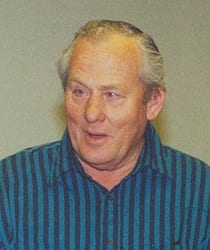Neil Brown
The Woods Hole Oceanographic Institution announces with great sorrow the death December 27, 2005 of Oceanographer Emeritus Neil L. Brown at the Royal Megansett Nursing & Retirement Home in North Falmouth, MA after a brief illness. He was 78.
Neil Lewis Brown was born July 19, 1927 in Moss Vale, New South Wales, Australia and received a diploma from Wallongang high school in 1943. He studied radio engineering at Sydney Technical College and pursued his interest in electrical engineering. While in college he worked for the Commonwealth Scientific & Industrial Research Organization (CSIRO) as a laboratory technician from 1944 to 1952 and as a technical officer/engineer from 1952 to 1956, making measurements in the Division of Electrotechnology at the National Standards Laboratory of CSIRO. He received a B. E. degree in electrical engineering in 1951 from the University of New South Wales, and continued to work for CSIRO, moving to the Division of Fisheries of the National Standards Laboratory in 1956 as a technical officer working with electronic instrumentation in oceanography. During his three years there, from 1956 to 1959, he developed a precision salinometer, the first of many oceanographic instruments he would develop during his lifetime.
Neil Brown’s first affiliation with the Woods Hole Oceanographic Institution came in 1960, when he joined the staff as a research associate. When his appointment as a visiting investigator at WHOI ended in 1961, he took a position as manager of research and development in the marine division at Bissett-Berman Corp. in San Diego, CA, where he developed the first widely used salinity measuring device, the STD (salinity/temperature/depth), later called a CTD (conductivity/temperature/depth).
He returned to WHOI in 1969 as a research specialist in the Ocean Engineering Department working with Doug Webb and was promoted to Senior Research Specialist in 1973. During this time he developed the Mk III CTD system, which became the mainstay of physical oceanography, and Neil Brown quickly became a leading authority on the measurement of salinity in seawater.
With the success of the CTD system, Neil Brown left the Institution in 1974 to found and serve as president of Neil Brown Instrument Systems in Falmouth and later Cataumet, MA. He continued to advance salinity measurements, developing the Mk V CTD system during the 1970s. In 1984 the firm was acquired by EG&G, and Neil Brown remained with the firm as a senior scientist until 1989, when he returned to WHOI as a senior research specialist in the Applied Ocean Physics and Engineering Department. In 1991 he was promoted to principal engineer. He retired from WHOI in 1995 and was named an Oceanographer Emeritus in 1999.
Neil was the author of more than 30 technical papers and held 26 patents in ocean instrumentation. Considered by many as one of the best oceanographic instrumentation engineers in the world, Neil Brown was recognized by colleagues for his talents and skills in designing and building instruments needed for the precision measurement of temperature, conductivity, pressure and velocity in the ocean. As one WHOI colleague noted, Neil Brown “had an ability to define his objectives clearly and comprehensively, he worked well with others, and was creative with a strong appreciation of the activities and problems of conducting research on physical oceanography. His technical competence was amazing,” another noted, “and he had few equals.”
Longtime colleague Sandy Williams calls Neil Brown’s invention of the first digital profiling instrument for measuring temperature and salinity as a function of depth “a revolutionary development. He called it the Micro Profiler because it could resolve temperature and salinity structure to a resolution of 15 cm in depth.” For this and other contributions to the field Neil Brown was awarded the Distinguished Technical Achievement Award by the Oceanic Engineering Society of IEEE in 1980. “There was a period about 14 years ago when I was pretty sure that Neil was responsible for more actual measurements in the ocean from his CTD than all the experimenters up to that time,” Sandy Williams recalled.
At WHOI, Neil worked with Doug Webb, Sandy Williams, Nick Fofonoff, Bob Millard, and many others in ocean instrumentation in the Applied Ocean Physics and Engineering Department and more recently Ray Schmitt in the Physical Oceanography Department. There his persistent push for better ocean instruments continued; he obtained his most recent patent just last year. Colleagues remember his kindly ways, skill in motivating and educating colleagues, and good humor. This was exemplified by his love of pranks and practical jokes, among them exploits with firecrackers. He was also an avid sailor, racing his boat “Escape” in Buzzards Bay for many years.
Survivors include two daughters, Ruth Brown of Winthrop, MA and Linden Brown Dick of Worcester, MA; two grandchildren, Alexandra Dick and Joshua Dick of Worcester; a brother, David Brown of Tamworth, New South Wales, Australia; and six nieces and nephews.
A celebration of life will be held Sunday, January 8, 2006 at 4 p.m. at Fisher House of Church of the Messiah on Church Street in Woods Hole. Donations in his memory may be made to the National Marine Life Center, 120 Main Street, Buzzards Bay, MA 02532.

